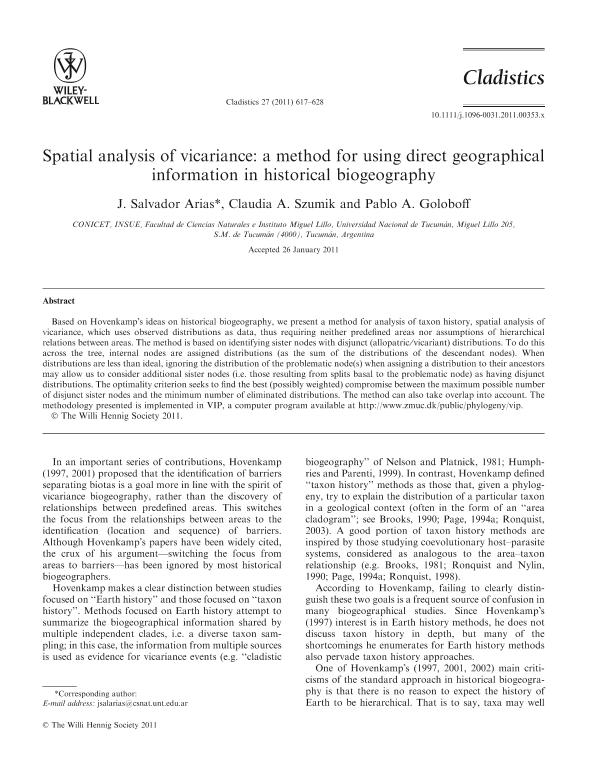Artículo
Spatial analysis of vicariance: A method for using direct geographical information in historical biogeography
Fecha de publicación:
12/2011
Editorial:
Wiley Blackwell Publishing, Inc
Revista:
Cladistics
ISSN:
0748-3007
Idioma:
Inglés
Tipo de recurso:
Artículo publicado
Clasificación temática:
Resumen
Based on Hovenkamp's ideas on historical biogeography, we present a method for analysis of taxon history, spatial analysis of vicariance, which uses observed distributions as data, thus requiring neither predefined areas nor assumptions of hierarchical relations between areas. The method is based on identifying sister nodes with disjunct (allopatric/vicariant) distributions. To do this across the tree, internal nodes are assigned distributions (as the sum of the distributions of the descendant nodes). When distributions are less than ideal, ignoring the distribution of the problematic node(s) when assigning a distribution to their ancestors may allow us to consider additional sister nodes (i.e. those resulting from splits basal to the problematic node) as having disjunct distributions. The optimality criterion seeks to find the best (possibly weighted) compromise between the maximum possible number of disjunct sister nodes and the minimum number of eliminated distributions. The method can also take overlap into account. The methodology presented is implemented in VIP, a computer program available at.
Palabras clave:
Taxon History
,
Hovenkamp
,
Spatial Analysis
,
Geographical Information
Archivos asociados
Licencia
Identificadores
Colecciones
Articulos(CCT - NOA SUR)
Articulos de CTRO.CIENTIFICO TECNOL.CONICET - NOA SUR
Articulos de CTRO.CIENTIFICO TECNOL.CONICET - NOA SUR
Articulos(UEL)
Articulos de UNIDAD EJECUTORA LILLO
Articulos de UNIDAD EJECUTORA LILLO
Citación
Arias Becerra, Joan Salvador; Szumik, Claudia Adriana; Goloboff, Pablo Augusto; Spatial analysis of vicariance: A method for using direct geographical information in historical biogeography; Wiley Blackwell Publishing, Inc; Cladistics; 27; 6; 12-2011; 617-628
Compartir
Altmétricas




